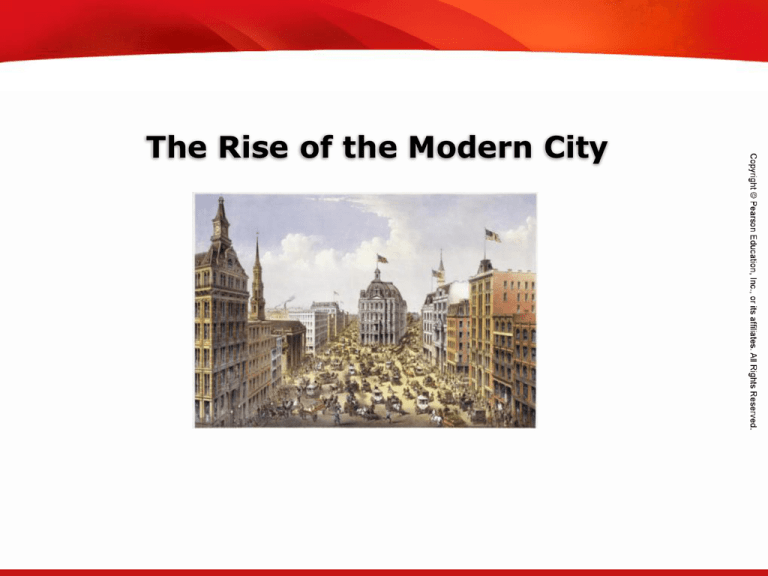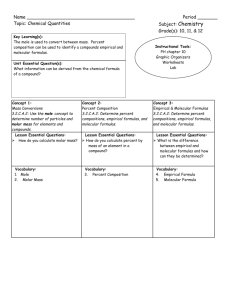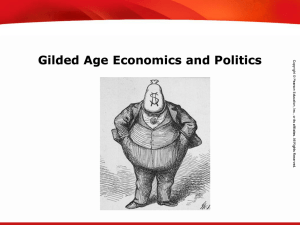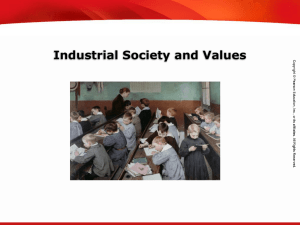The Rise of the Modern City
advertisement

TEKS 8C: Calculate percent composition and empirical and molecular formulas. The Rise of the Modern City TEKS 8C: Calculate percent composition and empirical and molecular formulas. Objectives • Summarize the impact of medical advances in the late 1800s. • Describe how cities had changed by 1900. • Explain how working-class struggles led to improved conditions for workers. TEKS 8C: Calculate percent composition and empirical and molecular formulas. Terms and People • germ theory – the idea that certain microbes cause specific infectious diseases • Louis Pasteur – a French chemist who showed the link between microbes and disease and developed vaccines against rabies and anthrax • Robert Koch – a German doctor who identified the bacterium that caused tuberculosis • Florence Nightingale – an army nurse in the Crimean War who worked to introduce sanitary measures in British hospitals and founded the world’s first school of nursing TEKS 8C: Calculate percent composition and empirical and molecular formulas. Terms and People (continued) • Joseph Lister – the English surgeon who discovered how antiseptics prevent infection • urban renewal – the process of fixing up the poor areas of a city • mutual-aid society – a self-help group formed to aid sick or injured workers • standard of living – a measure of the quality and availability of necessities and comforts in a society TEKS 8C: Calculate percent composition and empirical and molecular formulas. How did the Industrial Revolution change life in the cities? Cities grew during the 1800s as rural people moved into urban areas and the population continued to grow due to medical advances. Cities began to take on many of the features that they have today. TEKS 8C: Calculate percent composition and empirical and molecular formulas. Populations soared in Europe and America between 1800 and 1900. The death rate fell due to improved nutrition and significant advances in medicine. • Louis Pasteur proved germ theory, showing that microbes cause specific illnesses. • Robert Koch identified the cause of tuberculosis, a major cause of death. • As people understood the causes of disease, they bathed and changed their clothes more often. TEKS 8C: Calculate percent composition and empirical and molecular formulas. Hospital care also improved during the 1800s and early 1900s. • Anesthesia was first used in the 1840s and allowed doctors to experiment with new operations. • However, hospitals were dangerous places before people understood the importance of sanitation. • Florence Nightingale and Joseph Lister worked to improve hospital conditions, drastically reducing deaths from infection. TEKS 8C: Calculate percent composition and empirical and molecular formulas. Cities changed as industrialization progressed. • City planners led urban renewal projects. • Settlement patterns changed. The poor lived in slums at the center while the rich moved to the outskirts. • Architects used steel to construct soaring skyscrapers. TEKS 8C: Calculate percent composition and empirical and molecular formulas. Use of electricity continued to grow in the twentieth century. TEKS 8C: Calculate percent composition and empirical and molecular formulas. Cities installed street lights, organized police and fire forces, and dug sewers. Despite these improvements, poor people lived in bad conditions in slums. On the whole, however, cities were very attractive. People were drawn by the excitement, the promise of work, and entertainment. TEKS 8C: Calculate percent composition and empirical and molecular formulas. Workers tried to improve their living conditions. By the mid 1800s they began to see progress. • They formed mutual-aid societies to help sick or injured members. • Union membership grew and workers used strikes to demand wage increases. • Government also responded to pressure and passed laws to regulate working conditions and ban child labor. TEKS 8C: Calculate percent composition and empirical and molecular formulas. As the Industrial Revolution drew to a close, the standard of living rose among city dwellers. • Health improved and infant mortality decreased. • People had more time for leisure activities such as going to zoos, circuses, sporting events, and movies. • People ate better, dressed in mass-produced clothing, and bought more luxury goods. • Some workers moved to the suburbs. TEKS 8C: Calculate percent composition and empirical and molecular formulas. The Causes and Effects of the Industrial Revolution




